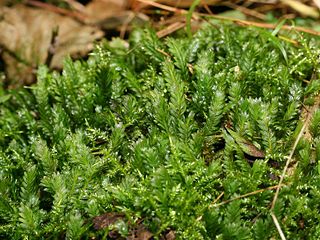
Fissidens adianthoides, the maidenhair pocketmoss, is a moss in the family Fissidentaceae. It was first collected by Hedwig in 1801.

Lycopodium clavatum is the most widespread species in the genus Lycopodium in the clubmoss family.
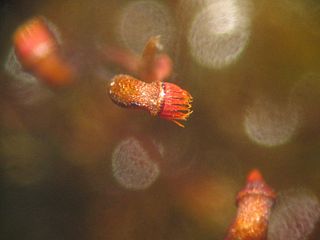
The Bryopsida constitute the largest class of mosses, containing 95% of all moss species. It consists of approximately 11,500 species, common throughout the whole world.
Bruchia bolanderi is a rare plant of the Western U.S.: Oregon, California, and Nevada. It grows on very damp bare soil. One may distinguish it from other mosses by the capsules, which are shaped like little upside-down pear fruits.

Tetraphidaceae is a family of mosses. It includes only the two genera Tetraphis and Tetrodontium, each with two species. The defining feature of the family is the 4-toothed peristome.
Philipp Bruch was a German pharmacist and bryologist born in Zweibrücken. His father, Johann Christian Bruch was also a pharmacist.
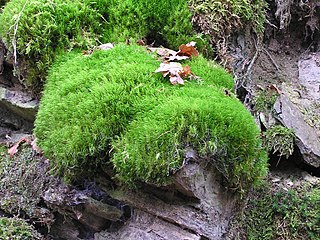
Dicranaceae is a family of haplolepideous mosses (Dicranidae) in class Bryopsida. Species within this family are dioicous. Genera in this family include Dicranum, Dicranoloma, and Mitrobryum.

Leucobryaceae is a family of haplolepideous mosses (Dicranidae) in the order Dicranales.

Splachnaceae is a family of mosses, containing around 70 species in 6 genera. Around half of those species are entomophilous, using insects to disperse their spores, a characteristic found in no other seedless land plants.

Climacium dendroides, also known as tree climacium moss, belongs in the order Hypnales and family Climaciaceae, in class Bryopsida and subclass Bryidae. It is identified as a "tree moss" due to its distinctive morphological features, and has four species identified across the Northern Hemisphere. The species name "dendroides" describes the tree-like morphology of the plant, and its genus name came from the structure of the perforations of peristome teeth. This plant was identified by Weber and Mohr in 1804. They often have stems that are around 2-10 cm tall and growing in the form of patches, looking like small palm-trees. They have yellow-green branches at the tip of stems. The leaves are around 2.5-3 mm long, with rounder stem leaves and pointier branch leaves. Their sporophytes are only abundant in late winter and early spring, and appears as a red-brown shoot with long stalk and cylindrical capsules.
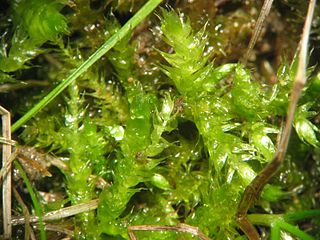
Brachytheciaceae is a family of mosses from the order Hypnales. The family includes over 40 genera and 250 species.

Andreaea rothii, or Roth's andreaea moss, is a species of moss in the family Andreaeaceae native to North America and parts of Europe. This plant was described in 1807 by Weber and Mohr.

Lycopodiella alopecuroides, the foxtail clubmoss, is a species of perennial vascular plant in the club-moss family, Lycopodiaceae. It is commonly found along the Atlantic seaboard and has been recently been discovered in the state of Maine. The family, Lycopodiaceae contains nearly 15 genera and about 375 species

Fissidens limbatus commonly known as Herzog's pocket-moss, is a moss in the family Fissidentaceae. This species is found growing in high elevations in tropical America in addition to the US, Mexico and Canada. Montagne first collected F. crispus in 1838.

Buxbaumia viridis, also known as the green shield-moss, is a rare bryophyte found sporadically throughout the northern hemisphere. The gametophyte of this moss is not macroscopically visible; the large, distinct sporophyte of B. viridis is the only identifying structure of this moss. This moss can be found singularly or in small groups on decaying wood, mostly in humid, sub-alpine to alpine Picea abies, Abies alba, or mixed tree forests. This moss is rare and conservation efforts are being made in most countries B. viridis is found in.

Plagiomnium venustum, also known as magnificent leafy moss, is a species of moss belonging to the family Mniaceae. It is found mainly in western North America along the coastal region. This moss can be identified from other members of the Plagiomnium genus by dark coloured stomata guide cells and the absence of sterile stems. It is most commonly found growing as a mat on a variety of substrate, but mainly on humus and moist soil.
Trematodon ambiguus is a species of moss belonging to the family Bruchiaceae.

Syntrichia latifolia, formerly Tortula latifolia, and commonly known as water screw-moss, is a species of moss belonging to the family Pottiaceae. Syntrichia species differ from members of Tortula due to synapomorphic leaf qualities, such as different basal and distal cells, as well as different costal cross sections where Tortula has an abaxial epidermis and Syntrichia lacks one.
Andreaea blyttii, also commonly known as Blytt's rock moss, is a moss belonging to the family Andreaeaceae, commonly known as rock moss, granite moss, or lantern moss because of this family's unique sporangium. It is part of the genus Andreaea which is known for forming dark brownish or reddish-black carpets in high elevations. This species was first described by Schimper in 1855.
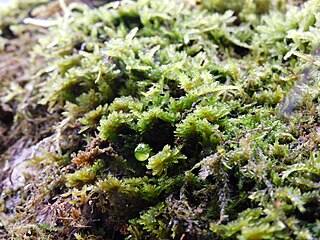
Leptodontaceae is a family of mosses belonging to the order Hypnales. There are 3 genera with a worldwide distribution.
















